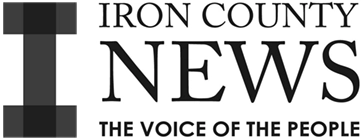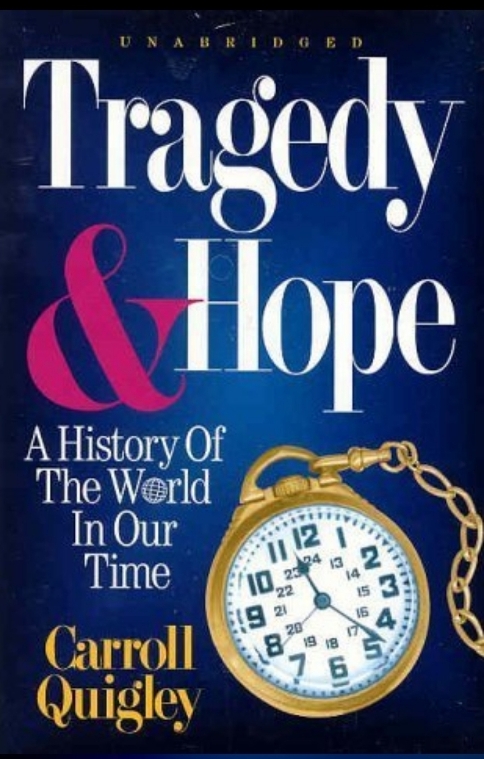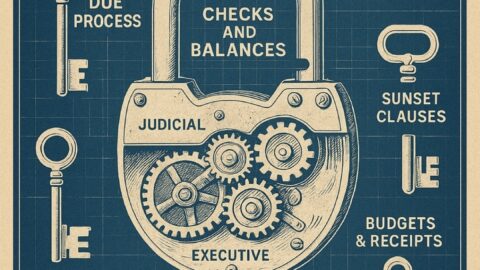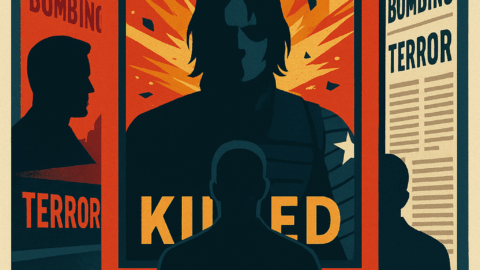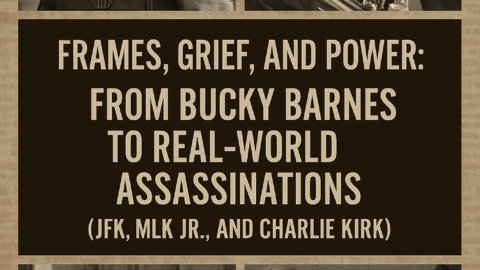Authors note: In the 1990s I came across this book by a mentor trying to show me what was happening in our country. Once you see it, you can’t unsee it. After Carroll Quigley inspected these records, he was for telling the world about the accomplishments of these collusive people, organizations, and corporations. He wanted the world to know instead of keeping it secret. In essence, this is your smoking gun on a grand conspiracy.
Carroll Quigley does make a noteworthy admission in his book “Tragedy and Hope: A History of the World in Our Time.” Quigley states that he had access to secret or private records of certain elite groups and institutions, which gave him unique insights into their activities, intentions, and influence on global affairs.
Quigley’s Admission Regarding Access to Secret Records:
- Access to Private Archives:
- In the introduction and various parts of “Tragedy and Hope,” Quigley mentions that he had access to the private records of some influential organizations, including groups that were involved in shaping world affairs. These organizations are often understood to include elite financial and political groups, such as the Council on Foreign Relations (CFR) and the Round Table groups, among others.
- Quigley claims he was able to study records that were not available to the general public, which provided him with a clearer understanding of how these groups operated, their strategies, and their goals.
- The Round Table Groups:
- Quigley specifically discusses his access to the archives of the Round Table groups, a network of British and American elites who aimed to influence global policy and maintain the British Empire’s influence in the world. These groups, founded in the early 20th century, sought to promote closer ties between the United States and the British Commonwealth and maintain a stable international order that aligned with their interests.
- His research into the activities and strategies of these groups forms a core part of his analysis in “Tragedy and Hope.” He describes their goals, such as promoting free trade, controlling monetary policy through central banking systems, and advocating for international cooperation through organizations like the League of Nations and, later, the United Nations.
- Rejection of Conspiracy Theories:
- Despite his access to secret records and his acknowledgment of the significant influence wielded by these elite groups, Quigley does not frame his findings as a grand conspiracy. He rejects the notion that a single, centralized conspiracy is controlling world events. Instead, he sees these groups as networks of influential people with shared interests who work together to shape policy and maintain stability.
- Quigley believed that these elites were often well-intentioned and aimed to create a more stable, prosperous world, even if their actions sometimes led to negative consequences or were carried out without public knowledge.
- Criticism of Secretive Influence:
- While Quigley does not endorse conspiracy theories, he is critical of the secretive nature of elite influence over democratic processes. He argues that this secrecy undermines democracy and the ability of citizens to make informed decisions. He calls for greater transparency in policymaking and more openness about the role and influence of these powerful groups.
Carroll Quigley’s admission of having access to secret records adds a unique dimension to “Tragedy and Hope.” It suggests that his analysis is based not only on publicly available information but also on private insights from within elite circles. This access allows Quigley to offer a perspective that is both critical of the concentration of power among elites and skeptical of simplistic conspiracy theories, arguing instead for a nuanced understanding of how global affairs are managed by interconnected networks of powerful individuals and organizations.
Key Themes and Arguments:
- The Concept of “Tragedy and Hope”:
- Title Meaning: The “tragedy” in the title refers to the destruction and chaos brought by wars, economic depressions, and totalitarian regimes in the first half of the 20th century. The “hope” represents the potential for a better future through the establishment of a more stable and cooperative international order, primarily led by Western democracies.
- Optimism for the Future: Despite the grim outlook of much of the 20th century, Quigley remains optimistic about the possibility of a more just and prosperous global system emerging from these crises.
- Historical Analysis of Global Events:
- World Wars and Revolutions: Quigley provides a detailed analysis of both World Wars, the Russian Revolution, and other major events, highlighting how these upheavals were influenced by economic interests and political ideologies. He argues that these events were shaped by the ambitions and rivalries of both nations and financial elites.
- Post-War Period: The book covers the period after World War II, including the emergence of the Cold War, the formation of the United Nations, and the restructuring of the global economy through institutions like the International Monetary Fund (IMF) and the World Bank. Quigley presents these developments as attempts to create a new world order that balances power and maintains peace.
- Economic Theories and Practices:
- Rise of Capitalism and Industrialization: Quigley examines the evolution of capitalism, the industrial revolution, and the creation of a global economic system. He focuses on the role of banks, corporations, and governments in shaping economic policy and practices, such as the establishment of central banking systems, which he views as tools to maintain elite control.
- Critique of Capitalism and Socialism: While Quigley is critical of both unchecked capitalism and centralized socialism, he argues that a mixed economic system—one that combines elements of both capitalism and government intervention—is necessary to achieve stability and equity.
- Critique of Conspiracy Theories:
- Acknowledgement of Elite Influence but Rejection of Conspiracy Theories: Quigley acknowledges that financial and political elites have a significant impact on world affairs, but he rejects the idea that this influence constitutes a grand conspiracy. Instead, he sees it as an open and often well-intentioned effort by powerful groups to manage global stability and economic growth.
- Call for Transparency and Reform: He calls for greater transparency in international policymaking and reforms to prevent the concentration of power in the hands of a few, suggesting that such measures would help create a more equitable world order.
- Analysis of Western Civilization:
- Cultural and Institutional Development: Quigley traces the development of Western civilization, analyzing the growth of political institutions, cultural values, and economic systems. He argues that Western civilization’s success is due to its adaptability, innovation, and balance between freedom and order.
- Decline and Renewal: Quigley also addresses the challenges facing Western civilization, including the risks of authoritarianism, moral decay, and economic inequality. He argues that to survive, the West must adapt by embracing both technological progress and social justice.
- Role of Education and Intellectual Leadership:
- Need for an Informed Citizenry: Quigley emphasizes the importance of education in creating an informed and active citizenry capable of participating in democratic governance. He argues that intellectual leadership is crucial in guiding society through the complexities of modern global politics.
“Tragedy and Hope: A History of the World in Our Time” by Carroll Quigley is a comprehensive and complex work that seeks to provide a broad historical context for understanding global political, economic, and social dynamics from the late 19th to the mid-20th century. While Quigley recognizes the significant influence of financial and political elites, he ultimately dismisses the notion of a grand conspiracy and instead presents these actions as a mix of self-interest and an effort to maintain order in a chaotic world. The book has been influential among those interested in political history, global affairs, and critiques of both the capitalist and socialist economic systems.
In “Tragedy and Hope: A History of the World in Our Time,” Carroll Quigley discusses the role and evolution of the Republican and Democratic parties in the United States, particularly focusing on their political strategies and alignment with the interests of elites.
Quigley’s Observations on the Republican and Democratic Parties:
- Lack of Fundamental Differences Between Parties:
- Quigley argues that by the mid-20th century, there was little fundamental difference between the Republican and Democratic parties in the United States. He believes both parties had come to represent similar interests, particularly those of the business and financial elite.
- According to Quigley, both parties were essentially committed to maintaining the existing political and economic system, including capitalism and the institutions of the state. The differences between them were more about specific policies and approaches rather than fundamental ideological distinctions.
- Shift Toward Centrism:
- Quigley contends that the American political system had been intentionally structured to provide voters with a choice between two centrist parties that would not threaten the established power structure. He suggests that this setup was designed to maintain stability by ensuring that political change would occur gradually and within the framework of the existing system.
- He explains that while the parties might differ in their rhetoric or in the specific policies they advocated, they both operated within a framework that was fundamentally supportive of the existing order.
- Manipulation by Financial and Economic Elites:
- Quigley argues that both parties were subject to the influence of financial and economic elites, who effectively shaped the policies of both Republicans and Democrats to serve their own interests. This influence was achieved through campaign contributions, lobbying, and other forms of political pressure.
- He points out that regardless of which party was in power, the elites were able to maintain their influence over government policy, ensuring that the core interests of powerful financial and corporate groups were always protected.
- Role in the Stability of the American System:
- Quigley asserts that this convergence of the two parties toward the center played a key role in maintaining the stability of the American political system. By ensuring that neither party would challenge the fundamental principles of the established order, elites were able to prevent the rise of more radical movements that might threaten their interests.
- He views the two-party system as a mechanism for managing dissent and containing political change within safe boundaries, preventing significant disruptions to the status quo.
- Critique of Voter Choice:
- Quigley critiques the illusion of choice presented by the two-party system, arguing that it offers voters only a limited range of options that ultimately serve the same elite interests. This setup, he suggests, diminishes the true power of democracy and reduces the possibility of meaningful political change.
Carroll Quigley’s analysis in “Tragedy and Hope” presents the Republican and Democratic parties as two sides of the same coin, both supporting and preserving the interests of financial and political elites. He argues that the convergence of these parties toward the center serves to maintain stability and prevent radical change, creating a system in which real differences between the parties are minimal and largely superficial. This structure, according to Quigley, is designed to manage political dissent and ensure the continuity of the existing power structure.
